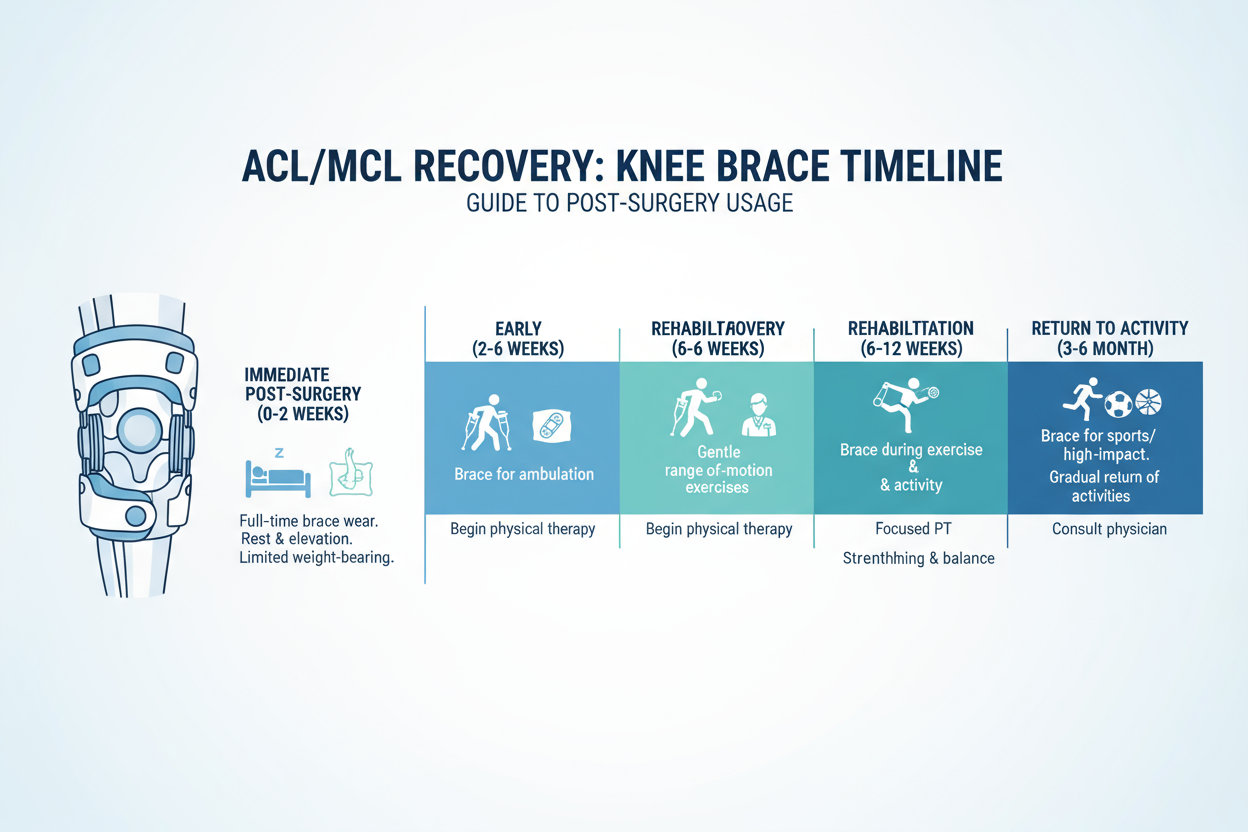After ACL or MCL surgery, most patients should wear a knee brace immediately after the procedure and continue using it for 6 to 12 weeks, depending on their doctor’s recommendation and recovery progress. The brace helps protect the healing ligaments, maintain joint stability, and prevent unwanted movement. As mobility improves, patients gradually transition from a post-surgical brace to lighter ACL braces or ACL knee support for everyday activity and sports rehabilitation.
Understanding ACL and MCL Surgery
The ACL (Anterior Cruciate Ligament) and MCL (Medial Collateral Ligament) are two of the most important ligaments in the knee. They provide stability during movement and protect the joint from overextension and twisting. When one of these ligaments tears, surgery is often required to restore full function especially for athletes or physically active individuals.
After surgery, the knee is vulnerable. The new ligament (or repaired tissue) needs time to heal, reattach, and strengthen. This is where a knee brace plays a crucial role it offers external support and ensures a safe recovery process.
Why Wearing a Knee Brace After Surgery Is Essential
A knee brace acts as a protective shield during the critical healing period. It:
- Prevents excessive movement that could damage the new graft or repaired tissue.
- Reduces pain and swelling by providing compression and stability.
- Encourages proper alignment of the knee joint during movement.
- Supports early mobility, helping you regain confidence while walking or doing therapy exercises.
Whether you’re recovering from an ACL reconstruction or an MCL repair, the right ACL knee support helps ensure that your knee heals correctly and safely.
The Recovery Phases and When to Wear a Knee Brace
Recovery from ACL or MCL surgery is typically divided into phases. Each stage has different brace requirements depending on activity level and tissue healing progress.
Phase 1: Immediate Post Surgery (Weeks 0-2)
Goal: Protect the surgical site and minimize swelling.
- The knee is usually placed in a locked brace immediately after surgery to limit movement.
- Patients are advised to wear the brace 24/7, even while sleeping.
- Crutches are typically used to avoid full weight bearing.
- The knee brace may be unlocked for gentle range of motion exercises under medical supervision.
During this phase, a post operative ACL brace ensures the new ligament isn’t overstretched or damaged.
Phase 2: Early Rehabilitation (Weeks 2-6)
Goal: Begin gentle movement while maintaining protection.
- The brace may be adjusted to allow limited bending (usually up to 90 degrees).
- Patients can gradually start weight-bearing as tolerated.
- It’s important to continue wearing the brace during walking, standing, and sleeping unless instructed otherwise by your doctor.
- Physical therapy begins to improve strength in the quadriceps and hamstrings.
This phase is critical using the right ACL knee support allows controlled mobility and prevents setbacks.
Phase 3: Strength and Balance (Weeks 6-12)
Goal: Build strength and improve stability.
- At this point, many patients transition from a rigid brace to a functional ACL brace for sports or moderate activity.
- The brace provides enough flexibility to move freely while still supporting the joint during exercises.
- It’s worn during therapy sessions, walking, and light activities.
Athletes often continue to wear ACL braces throughout this stage to build confidence during lateral movements and light sports drills.
Phase 4: Advanced Rehabilitation (3-6 Months)
Goal: Regain agility and dynamic strength.
- As stability improves, your therapist may allow you to stop using a brace for normal walking but recommend it during exercise or sport-specific training.
- A functional ACL knee support or ACL brace for sports helps protect the joint during cutting, pivoting, or jumping drills.
- The brace serves as a reminder to move cautiously and avoid re injury.
This is when patients begin to feel “normal” again but internal healing continues, so bracing remains beneficial for safety.
Phase 5: Return to Sports (6-12 Months)
Goal: Full return to sport and performance.
- Before returning to competitive sports, most doctors recommend wearing an ACL brace for sports for at least 6-12 months.
- The brace minimizes the risk of re tearing the ligament by stabilizing the joint during fast direction changes.
- Over time, as strength and balance fully return, bracing can be reduced but should still be used in high risk activities.
Even professional athletes often continue using ACL braces during games or training sessions as a preventive measure.
Choosing the Right ACL Brace After Surgery
There are several types of ACL braces, each designed for different recovery phases:
- Post-Surgical Hinged Brace:
- Rigid, adjustable, and typically worn immediately after surgery.
- Limits range of motion to protect the healing ligament.
- Functional ACL Brace for Sports:
- Designed for later stages of recovery.
- Provides stability during dynamic movements like running or pivoting.
- Lightweight and breathable for long-term wear.
- Soft Compression ACL Knee Support:
- Offers mild support and improves circulation.
- Ideal for maintenance, prevention, or light activity after full recovery.
Your orthopedic specialist or physical therapist will guide you in selecting the best option based on your activity level and healing progress.
How Long Should You Wear a Knee Brace Each Day?
- Weeks 0-6: Usually full-time wear (day and night).
- Weeks 6-12: Worn during activity, therapy, and walking.
- After 3 months: During sports or physically demanding activities only.
Consistency is crucial removing the brace too soon can lead to instability, delayed healing, or re injury.
Combining Bracing with Physical Therapy
A knee brace is not a substitute for rehabilitation. It works best when combined with:
- Strength training: Focus on quadriceps, hamstrings, and glutes.
- Balance exercises: Improve control and joint awareness (proprioception).
- Flexibility routines: Maintain full range of motion without straining the ligament.
Physical therapy ensures that your muscles take over the role of stabilizing the knee once the brace is no longer required.
Tips for Safe and Effective Brace Use
- Follow medical guidance: Never adjust your brace without consulting your doctor.
- Keep it clean: Wash liners and straps regularly to avoid skin irritation.
- Check the fit: A brace that’s too loose won’t provide support; one that’s too tight can restrict blood flow.
- Use during risk activities: Even after recovery, wear your ACL brace for sports during high-impact workouts.
- Listen to your body: Pain, swelling, or stiffness may mean you need continued brace use or additional therapy.
When to Stop Wearing the Brace
You can gradually stop wearing the brace when:
- Your doctor confirms full ligament healing.
- You can perform functional movements (jumping, pivoting, running) without pain or instability.
- You’ve regained full strength, range of motion, and confidence in the knee.
For many, this occurs around 6-9 months post-surgery, though high-performance athletes often wear ACL braces longer for prevention.
Conclusion
After ACL or MCL surgery, you should wear a knee brace right away and continue for 6 to 12 weeks, transitioning to lighter ACL knee support as your recovery advances. The brace protects your repaired ligament, prevents reinjury, and supports a gradual return to sports. For athletes, using an ACL brace for sports even after recovery adds extra safety and confidence during high intensity performance.
Wearing the right brace at the right time combined with consistent rehabilitation is the key to a strong, stable, and lasting recovery.









